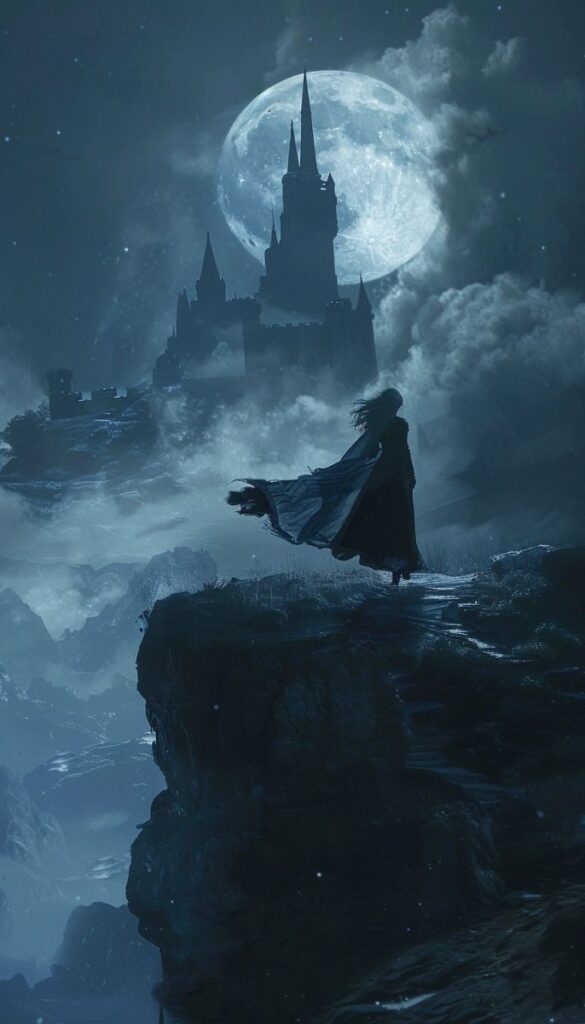Fairy tales — the phrase alone conjures up images of glass slippers, magical kisses, talking mirrors, and happy endings. But beneath the sparkle and the songs lies something older, deeper, and far darker.
Before fairy tales were bedtime stories, they were cautionary tales — brutal, violent, and unflinchingly honest about human nature. If you’ve ever wondered why How Fairy Tales Have Always Been Darker Than We Think, you’re about to step into the shadowy forest where it all began.
🌒 The Forgotten Roots of Fairy Tales
To understand how fairy tales have always been darker than we think, we must go back to their origins — long before Disney, before picture books, even before printing presses.
Fairy tales began as oral folklore, passed down from generation to generation. They were told by villagers around fires, by parents warning their children not to wander into the woods, and by weary travelers who shared tales of danger and magic. These weren’t bedtime comforts; they were survival guides.
The earliest versions of these stories were meant to teach moral lessons — not to delight children. They reflected a time when life was harsh, justice was cruel, and people relied on superstition to make sense of a chaotic world.
When we think of dark fairy tales for adults, this is what they were. The original fairy tales were filled with violence, betrayal, punishment, and sometimes even cannibalism. And they weren’t ashamed of it.
🕯️ The Grimm Brothers and Their Real Fairy Tales
If anyone deserves credit (or blame) for shaping how fairy tales reached the modern world, it’s Jacob and Wilhelm Grimm — the Grimm Brothers.
Their 19th-century collection, Children’s and Household Tales, was never originally meant for children. In fact, the real fairy tales Grimm Brothers published were meant as cultural preservation projects — to capture the oral traditions of Germany before industrialization erased them.
But the tales they collected were chilling.
- In the original Cinderella, the stepsisters cut off parts of their feet to fit into the slipper, and birds pecked their eyes out at the wedding.
- In Snow White, the queen wasn’t banished — she was forced to dance to her death in red-hot iron shoes.
- In Hansel and Gretel, the witch wasn’t merely an evil hag; she was a reflection of the famine-driven fear of parents abandoning their own children.
- And in Sleeping Beauty, the prince didn’t wake her with a kiss — in some early Italian versions, he violated her while she slept.
These are not child-friendly tales. They are the unfiltered echoes of centuries of hardship. When people read the dark fairy tales Brothers Grimm compiled, they see humanity at its rawest — desperate, afraid, and full of contradictions.
🩸 Every Fairy Tale Has a Dark Side
There’s a reason the phrase “every fairytale has a dark side” rings true — because it does. The darkness wasn’t an accident; it was essential.
In an era before modern law and psychology, fairy tales acted as moral codes. Evil was punished, greed destroyed, and innocence tested. But these lessons came wrapped in fear.
The darkness was the warning — stray too far, disobey your parents, be greedy, trust a stranger — and you might meet your doom.
When you think of dark fairy tales for adults, remember: these weren’t just stories; they were emotional armor for societies that had little protection from real-life horror.
Wolves weren’t just wolves — they were metaphors for predators in disguise. Witches weren’t just spell-casters — they were symbols of female power and fear. Castles, forests, and curses all had meaning, mirroring the fears and taboos of their time.
🧙♀️ The Meaning of a Dark Fairy Tale
So what exactly is the dark fairy tale meaning?
A dark fairy tale doesn’t simply mean one filled with gore or death. It’s a narrative that dives into the shadow side of humanity — envy, lust, power, betrayal, revenge — the things polite society doesn’t like to talk about.
It’s the acknowledgment that good and evil often live inside the same person.
Modern psychology even recognizes this. Carl Jung’s idea of the “shadow self” — the hidden, darker part of our psyche — echoes perfectly with fairy tale motifs. The stepmother, the beast, the witch — they all represent what we repress but must face to grow.
That’s why How Fairy Tales Have Always Been Darker Than We Think isn’t just about storytelling. It’s about how we understand ourselves.
👑 The Sanitization of Stories: From Firelight to Disney
At some point, fairy tales went from terrifying folklore to glittering entertainment. How? Enter the Victorians and Disney.
The Victorians began “sanitizing” fairy tales for moral education. They erased sexual themes, softened the violence, and made sure virtue was always rewarded.
Then, in the 20th century, Walt Disney sprinkled magic dust on them. His films brought color, charm, and joy to the world — but also edited out the fear.
The original Little Mermaid dies and turns into sea foam — Disney gave her a happily ever after.
In the Hunchback of Notre Dame, everyone dies — Disney added a song and a moral lesson.
While Disney gave us childhood nostalgia, it also erased the primal power that once defined fairy tales.
Riya’s Blogs has often discussed the beauty in truth-telling through storytelling — and this is where truth and fantasy collided. We began to believe that fairy tales were simple stories of good triumphing over evil. But the originals were never that naïve.
🌹 The Real Power of Darkness
The darkness in fairy tales isn’t gratuitous — it’s transformative.
When Beauty and the Beast explores the nature of love and ugliness, it’s not a romance; it’s a parable about seeing the monster within.
When Bluebeard tells the story of a murderous husband, it warns of blind trust and curiosity.
When Little Red Riding Hood meets the wolf, it’s a coming-of-age story about danger and desire.
These stories hold power because they’re honest. They show that even in a world of magic, you cannot escape cruelty, temptation, or loss.
That’s why dark fairy tales for adults are making a comeback today — in films, books, and even dark fairy tale story anime. We crave meaning that goes beyond “happily ever after.”
🧵 A Dark Fairy Tales List: Beyond the Classics
Let’s take a closer look at some famous dark fairy tales list entries that still chill the spine today:
- Bluebeard – A woman discovers her husband’s secret room filled with corpses of his previous wives.
- The Juniper Tree – A stepmother kills her stepson and serves him as dinner to his father.
- The Red Shoes – A girl’s vanity leads her to wear cursed shoes that make her dance until she dies.
- Rapunzel (original) – Not a sweet romance; it ends in blindness, imprisonment, and despair.
- The Goose Girl – A princess’s maid takes her identity, leading to gruesome justice.
- The Little Mermaid (Andersen) – A tragic tale of unrequited love and sacrifice, not a Disney dream.
- The Pied Piper of Hamelin – After being betrayed, the Piper lures all the town’s children into a mountain, never to return.
- Snow White – Poison, vanity, and torture wrapped in a tale of beauty.
- Sleeping Beauty (Briar Rose) – Themes of consent and fate intertwine disturbingly.
- Hansel and Gretel – Child abandonment, starvation, and murder — all in one “children’s tale.”
Every story on this dark fairy tales list carries a warning — every fairytale has a dark side because every truth has its price.
🌙 Why Do We Still Love Them?
It might seem strange that we’re drawn to these grim tales. But it’s precisely because they tell the truth — life is not always fair, and evil doesn’t always wear horns.
Even how fairy tales fairy tales evolved over centuries shows us that we crave a balance — light and dark, innocence and danger, hope and despair.
As adults, we return to these tales because we recognize ourselves in them. We’ve seen deceit, heartbreak, betrayal. Fairy tales help us process these emotions symbolically.
They tell us that even when monsters exist — inside or outside — courage, cleverness, or kindness can still change our fate.
📚 Fairy Tales Across Cultures: Not All Happily Ever After
The darkness of fairy tales isn’t just a European phenomenon. Across the world, stories mirror the same shadows:
- In Japanese folklore, spirits called yōkai often test human morality — much like dark fairy tale story anime today.
- In Indian Panchatantra tales, cunning and cruelty coexist with wisdom.
- In Russian tales, Baba Yaga — the witch in the woods — is both villain and mentor.
- In African and Native American legends, tricksters like Anansi or Coyote embody chaos and consequence.
These tales show us that across civilizations, storytelling has always used darkness to illuminate truth.
💭 “Fairy Tales Are Real” — A Quote That Rings True
There’s an old fairy tales are real quote that says:
“Fairy tales are more than true — not because they tell us dragons exist, but because they tell us dragons can be beaten.”
That line, from G.K. Chesterton and later popularized by Neil Gaiman, captures the heart of it all.
We don’t love fairy tales because they’re innocent. We love them because they let us face the darkness safely.
That’s the essence of How Fairy Tales Have Always Been Darker Than We Think. The real magic isn’t the spell or the slipper — it’s the human ability to find light in shadow.
🖋️ Modern Reimaginings: The Return of the Dark
In recent years, storytellers have begun to reclaim that darkness. Shows like Once Upon a Time, movies like Pan’s Labyrinth, and dark fairy tales for adults in literature — from Angela Carter’s The Bloody Chamber to Neil Gaiman’s The Sleeper and the Spindle — bring back the haunting beauty of the originals.
Even anime and graphic novels explore dark fairy tale story anime arcs — tragic princesses, cursed heroes, and twisted morals that mirror life’s grayness.
In these retellings, the monsters aren’t just villains — they’re metaphors for grief, trauma, and transformation.
Riya’s Blogs believes that storytelling is most powerful when it mirrors both hope and horror — and fairy tales embody exactly that duality.
🌹 Conclusion: Why the Darkness Matters
How Fairy Tales Have Always Been Darker Than We Think isn’t merely an observation — it’s a reminder.
We grew up believing in happy endings, but fairy tales remind us that endings are earned through struggle. They show us that kindness matters precisely because cruelty exists.
The original fairy tales dark versions weren’t cruel for the sake of cruelty — they were honest. They taught generations how to live with courage, compassion, and wisdom in an uncertain world.
So the next time you hear “once upon a time”, remember — it’s not just a story. It’s a reflection of life itself: beautiful, brutal, and profoundly human.
Because in the end, every fairytale has a dark side — and that’s exactly what makes it timeless.

Want to read a bit more? Find some more of my writings here-
Richard Ramirez: The Night Stalker Who Terrorized California
A Coffee Cup That Knows Your Secrets: A Short Story
Book Review: Good Girl, Bad Blood by Holly Jackson
I hope you liked the content.
To share your views, you can simply send me an email.
Thank you for being keen readers to a small-time writer.







